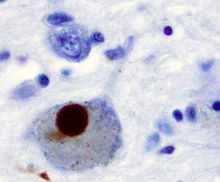Synucleinopathies
Synucleinopathies (also called α-Synucleinopathies) are neurodegenerative diseases characterised by the abnormal accumulation of aggregates of alpha-synuclein protein in neurons, nerve fibres or glial cells.[1] There are three main types of synucleinopathy: Parkinson's disease, dementia with Lewy bodies, and multiple system atrophy.[1] Other rare disorders, such as various neuroaxonal dystrophies, also have α-synuclein pathologies.[1]

Positive α-Synuclein staining of a Lewy body in a patient with Parkinson's disease.
Because each of the synucleinopathies has a distinct set of symptoms, prognosis and management issues, it has been suggested that the term "has little practical value as a diagnostic term for the clinician."[2]
See also
References
- ↑ 1.0 1.1 1.2 McCann, H; Stevens, C. H.; Cartwright, H; Halliday, G. M. (2014). "Α-Synucleinopathy phenotypes". Parkinsonism & Related Disorders. 20 Suppl 1: S62–7. doi:10.1016/S1353-8020(13)70017-8. PMID 24262191.
- ↑ Martí MJ, Tolosa E, Campdelacreu J. (Sep 2003). "Clinical overview of the synucleinopathies". Movement Disorders 18 (Suppl 6): S21–7. doi:10.1002/mds.10559. PMID 14502652.